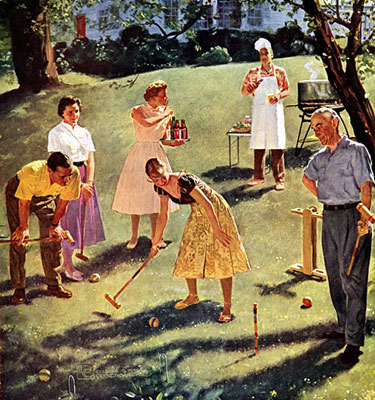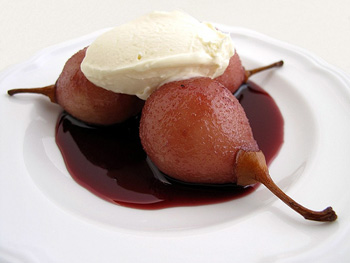 Pears have a special place in my childhood. When I was a kid, my family would pick pears from the trees in my aunt and uncle's backyard. They always had more pears than they knew what to do with. My aunt made pear sauce, much like apple sauce, and my mom would can the pears to be eaten as compote. We would also eat them raw, when their so sweet, juicy, and buttery. I love them that way, but often enough the ones you buy in the market are not the best to eat out of hand. That's when I like to poach pears to create a unique dessert.
Pears have a special place in my childhood. When I was a kid, my family would pick pears from the trees in my aunt and uncle's backyard. They always had more pears than they knew what to do with. My aunt made pear sauce, much like apple sauce, and my mom would can the pears to be eaten as compote. We would also eat them raw, when their so sweet, juicy, and buttery. I love them that way, but often enough the ones you buy in the market are not the best to eat out of hand. That's when I like to poach pears to create a unique dessert.
Poaching pears in red wine turns them into glowing red jewels with tender and succulent flesh, flavored by the spiced poaching liquid. Spices such as cinnamon, nutmeg, cloves, cardamom, or star anise can be added for exotic flavor. Citrus rind or tea leaves, like Earl Grey, also add flavor. The composition is up to you but the cooking method is simple. Once the pears are cooked, the poaching liquid can be reduced to create a syrup. Serve the pears with the reduction sauce and a dollop of crème fraîche for a very elegant dessert that would make a lovely ending to any dinner party.
Fall
Fall
Despite its looks, don't chintz on the quince
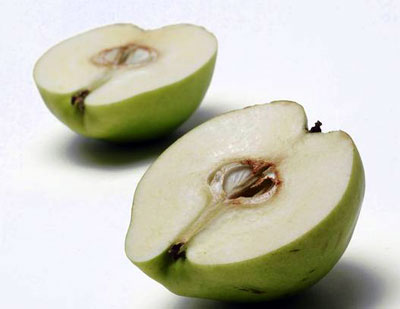 At first glance — and even, quite frankly, after extended contemplation — there is little to hint that the quince is one of the most delicious of fall's fruits. It is rough-hewn and blocky in appearance, like someone's first woodworking project gone horribly wrong. And should you make the mistake of taking a bite of it raw, that's kind of how it tastes too.
At first glance — and even, quite frankly, after extended contemplation — there is little to hint that the quince is one of the most delicious of fall's fruits. It is rough-hewn and blocky in appearance, like someone's first woodworking project gone horribly wrong. And should you make the mistake of taking a bite of it raw, that's kind of how it tastes too.
But you know about judging things on first impressions. Take that same quince, give it a little careful tending and you'll find a fruit that is utterly transformed. Cook quince — slowly and gently, bathed in just a little bit of sugar syrup — and the flesh that was once wooden and tannic turns a lovely rose hue, with a silky texture and a subtly sweet, spicy flavor that recalls apples and pears baked with cinnamon and clove.
The traditional way to cook a quince is by poaching it in spiced simple syrup. That's easy enough, but I've come to favor a slightly different technique from my old friend Deborah Madison's cookbook "Seasonal Fruit Desserts." She bakes them in a syrup made partly with white wine and spiced with cinnamon, clove and cardamom along with tangerine or orange zest.
Time for Apples
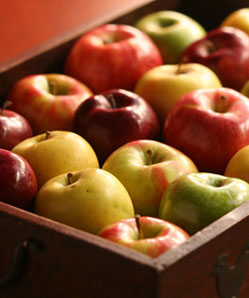 Last year I discovered that I actually enjoyed apples. I realize they are one of the most basic things on the planet and I won’t even pretend to touch on their historical or metaphorical influence, but let’s just say that the apple never made its way into my list of food cravings or desires. I never bothered picking any up at the market, I never found them particularly sexy or exciting and I figured as long as I worked on Mac computers I was surrounded enough by them. Then a little thing happened where I tried a new crop Vasquez apple and realized what all the fuss was about. Apart from being nutritional gems, I was pleasantly surprised that an apple could be crisp, non-mealy, pleasant, and provide a happy balance between tart and sweet, or even not so sweet and just overall refreshing. Ok ok, I know what you’re thinking: um, could Matt come to this apple party any later in life? It’s ok, I completely agree. In fact I had never really shared my blasé attitude about them until it was replaced by my love affair with apples.
Last year I discovered that I actually enjoyed apples. I realize they are one of the most basic things on the planet and I won’t even pretend to touch on their historical or metaphorical influence, but let’s just say that the apple never made its way into my list of food cravings or desires. I never bothered picking any up at the market, I never found them particularly sexy or exciting and I figured as long as I worked on Mac computers I was surrounded enough by them. Then a little thing happened where I tried a new crop Vasquez apple and realized what all the fuss was about. Apart from being nutritional gems, I was pleasantly surprised that an apple could be crisp, non-mealy, pleasant, and provide a happy balance between tart and sweet, or even not so sweet and just overall refreshing. Ok ok, I know what you’re thinking: um, could Matt come to this apple party any later in life? It’s ok, I completely agree. In fact I had never really shared my blasé attitude about them until it was replaced by my love affair with apples.
Now it seems I have random apples wherever I go. They are the perfect snack for me because they are portable, durable, fit in my computer bag and allow me to save those annoying little stickers with the PLU on them and put them on my fingernails and point at things until people notice. Plus they signal the arrival of fall and all the good stuff that is to come. It’s that new-crop versus cold-storage thing, not that I don’t eat the latter. And on rare occasions the apple allows me to observe mother nature’s miraculous break down of plant matter when a stray apple rolls out of my bag and under the passenger seat of my car, scenting my ride with the happy smell of Pink Lady* before giving way to the odor of rotting flesh, its origin alluding me until I take my vehicle to the car wash. And here I thought it was just the smell of Carson, California.
Falling for Grapes in Salad
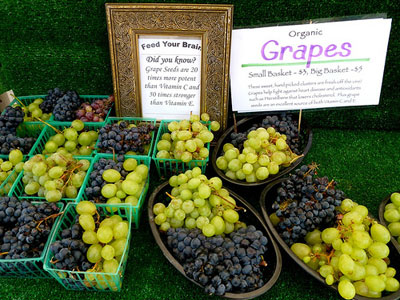 Now that we're headin into Fall, it's now time for full-fledged autumn salads.You know, the kind with thick slabs of roasted squash, wedges of spicy persimmons, and robust dressings made with maple syrup and heady herbs such as rosemary and sage.
Now that we're headin into Fall, it's now time for full-fledged autumn salads.You know, the kind with thick slabs of roasted squash, wedges of spicy persimmons, and robust dressings made with maple syrup and heady herbs such as rosemary and sage.
While most fall salads include apples, pears, and fresh figs, not many include of one autumn's most popular fruits: grapes. Perhaps that's because like bananas, grapes are available in our supermarkets year-round and don't seem to have a specific season. Well, they do. Most grapes in the US are grown in California and are harvested between August and December. They're also available at San Diego farmers' markets right now.
I wish I could have you taste some of our local grapes. They're like nothing you've ever tasted from the supermarket. That's because no matter the variety – Champagne, Thompson, Concord, Flame – the grapes aren't picked until fully vine-ripened, which makes them dizzyingly plump, juicy, and flavorful. When you bite into some varieties, they release bursts of juice so intense, you'd think you're drinking wine.
My Favorite Apple Crisp
 Despite the warm weather we’ve been enjoying in Southern California, a recent trip to my local grocery store reminded me that fall is here – pyramid-like mounds of pumpkins filled the entrance, flanked by bins of apples of every variety.
Despite the warm weather we’ve been enjoying in Southern California, a recent trip to my local grocery store reminded me that fall is here – pyramid-like mounds of pumpkins filled the entrance, flanked by bins of apples of every variety.
Although apples are available all year, they are particularly sweet and delicious this time of year. I generally mark apple picking season with a home-baked double crust pie, but some people still find it a daunting task. If you’re one of them, make apple crisp your signature fall dish.
This is one of my favorite recipes because it produces a thicker layer of “crisp” – which frankly is the best part. The chewy, buttery, caramel flavored brown sugar oatmeal laced layer compliments the apples perfectly. Choose a variety of apples from your local growers – and try to choose organic.
The average conventionally grown apple has more pesticide residue on it than any other fruit or vegetable. According to the Environmental Working Group‘s analysis of USDA data, “pesticides showed up on 98 percent of the more than 700 apple samples tested (yes, they were washed).”
More Articles ...
Welcome to the new One for the Table ...
Our Home Page will be different each time you arrive.
We're sure you'll find something to pique your interest...

